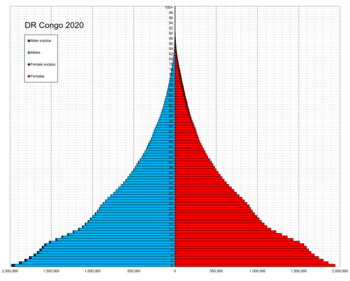
Back Население на Демократична република Конго Bulgarian Demografía de la República Democrática del Congo Spanish Démographie de la république démocratique du Congo French კონგოს დემოკრატიული რესპუბლიკის დემოგრაფია Georgian 콩고 민주 공화국의 인구 Korean Kongo Demokratinės Respublikos demografija Lithuanian Mponina ao amin' ny Repoblika Demôkratikan' i Kôngô Malagasy Демографија на Демократската Република Конго Macedonian Demografia da República Democrática do Congo Portuguese Населення Демократичної Республіки Конго Ukrainian
| Demographics of Democratic Republic of the Congo | |
|---|---|
 Population pyramid of the Democratic Republic of the Congo in 2020 | |
| Population | 95,894,118 (2021 est.) |
| Growth rate | 3.24% (2022 est.) |
| Birth rate | 40.08 births/1,000 population (2022 est.) |
| Death rate | 7.94 deaths/1,000 population (2022 est.) |
| Life expectancy | 61.83 years |
| • male | 60.03 years |
| • female | 63.69 years |
| Fertility rate | 6.16 children born/woman (2022 est.) |
| Infant mortality rate | 60.85 deaths/1,000 live births |
| Net migration rate | -0.71 migrant(s)/1,000 population (2022 est.) |
| Age structure | |
| 0–14 years | 46.38% |
| 65 and over | 2.47% |
| Sex ratio | |
| Total | 1 male(s)/female (2022 est.) |
| At birth | 1.03 male(s)/female |
| Under 15 | 1.01 male(s)/female |
| 65 and over | 0.6 male(s)/female |
| Nationality | |
| Nationality | Congolese |
| Language | |
| Official | French |

Demographic features of the population of the Democratic Republic of the Congo include ethnicity, education level, health, economic status, religious affiliations and other aspects of the population.
As many as 250 ethnic groups have been distinguished and named.[1] The most numerous people are the Luba, Mongo, and Kongo.
Although 700 local languages and dialects are spoken, the linguistic variety is bridged both by the use of French, and the intermediary languages Kikongo ya leta, Tshiluba, Swahili, and Lingala.
- ^ "Congo (Kinshasa) (01/08)". U.S. Department of State. Retrieved 2022-12-16.